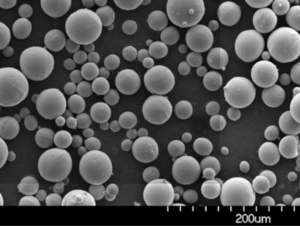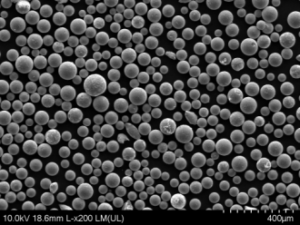Introdução: Por que o Pó Esférico é um Ponto de Mudança na Fabricação Moderna
Imagine tentar encher um pote com bolinhas de gude e pedregulhos. As bolinhas de gude, lisas e uniformes, deslizam para o lugar sem esforço, deixando o mínimo de espaços. Agora, imagine fazer o mesmo com pedregulhos de formato irregular. Você teria dificuldade em compactá-los, certo? Este é o princípio por trás do pó esférico—pequenas partículas uniformes que fluem e se compactam de forma eficiente, revolucionando indústrias desde a aeroespacial até a engenharia biomédica.
Neste artigo, mergulharemos no mundo do pó esférico. Exploraremos seus vários tipos, investigaremos suas propriedades únicas e discutiremos por que ele é o material de escolha para a fabricação de alta precisão. Também compararemos diferentes modelos, delinearemos seus usos específicos e o guiaremos pelos prós e contras de cada um. Seja você um engenheiro experiente ou apenas curioso sobre materiais de ponta, este guia tem algo para você.
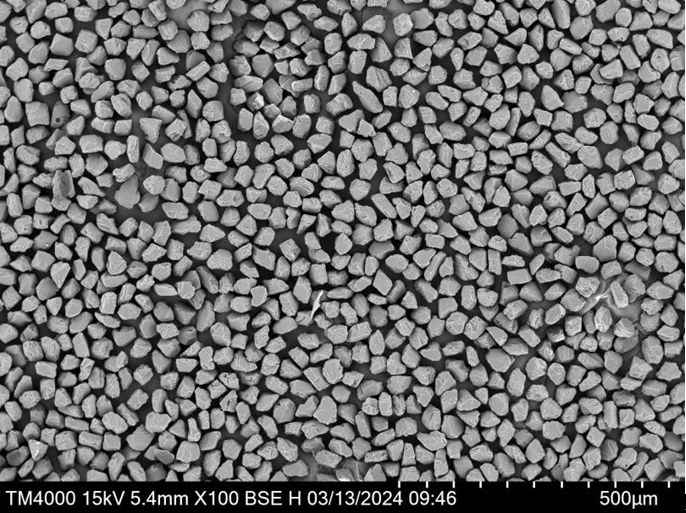
Visão Geral do Pó Esférico
O que é exatamente o Pó Esférico?
O pó esférico consiste em partículas finas e redondas que são tipicamente criadas usando processos como atomização. Esses pós são muito procurados devido à sua fluidez e densidade de compactação superiores em comparação com partículas de formato irregular. Seja você falando de metais, cerâmicas ou polímeros, se for esférico, é mais eficiente trabalhar com ele.
Por que a forma é importante
A forma esférica é mais do que apenas esteticamente agradável. É a chave para obter revestimentos uniformes, precisão na fabricação aditiva e até mesmo consistência em produtos como produtos farmacêuticos. Quando se trata de fabricação, uniformidade e previsibilidade são tudo. Imagine assar um bolo com ingredientes de diferentes formatos e tamanhos — algumas partes cozinham mais rápido, outras mais lentamente, levando a um resultado desigual. O pó esférico garante que cada 'ingrediente' seja uniforme, resultando em um produto final superior.
Composição do Pó Esférico
Tipos de Pó Esférico e Suas Composições
Diferentes indústrias exigem diferentes tipos de pós esféricos, cada um com sua composição única adaptada a aplicações específicas. Aqui está uma análise mais detalhada de alguns dos tipos mais comuns:
| Tipo de Pó Esférico | Composição primária | Características | Formulários |
|---|---|---|---|
| Pó Esférico de Titânio | Titânio (Ti) | Alta resistência, leve, resistente à corrosão | Aeroespacial, implantes biomédicos |
| Pó Esférico de Alumínio | Alumínio (Al) | Excelente condutividade, leve | Automotivo, eletrônicos, fabricação aditiva |
| Pó Esférico de Cobre | Cobre (Cu) | Alta condutividade térmica e elétrica | Eletrônicos, dissipadores de calor, revestimentos condutivos |
| Pó Esférico de Aço Inoxidável | Ferro (Fe), Cromo (Cr), Níquel (Ni) | Resistência à corrosão, durabilidade | Dispositivos médicos, automotivo, ferramentas |
| Pó Esférico de Níquel | Níquel (Ni) | Alta temperatura e resistência à corrosão | Aeroespacial, energia, fabricação aditiva |
| Pó Esférico de Cobalto-Cromo | Cobalto (Co), Cromo (Cr) | Biocompatibilidade, resistência ao desgaste | Implantes médicos, odontologia, aeroespacial |
| Pó Esférico de Tungstênio | Tungstênio (W) | Alta densidade, resistência ao calor | Blindagem contra radiação, aeroespacial, defesa |
| Pó Esférico de Ferro | Ferro (Fe) | Propriedades magnéticas, acessibilidade | Materiais magnéticos, automotivo, fabricação aditiva |
| Pó Esférico de Zinco | Zinco (Zn) | Resistência à corrosão, propriedades de galvanização | Galvanização, fundição sob pressão, eletrônicos |
| Pó Esférico de Silício | Silício (Si) | Propriedades semicondutoras, resistência ao calor | Eletrônicos, células solares, fabricação aditiva |
Compreendendo a Composição e Seu Impacto no Desempenho
A composição de um pó esférico impacta diretamente seu desempenho em diferentes aplicações. Por exemplo, a biocompatibilidade e a resistência do titânio o tornam ideal para implantes médicos, enquanto a leveza do alumínio é perfeita para peças automotivas. Ao entender essas composições, os fabricantes podem selecionar o pó certo para suas necessidades específicas.
Características do Pó Esférico
Propriedades-chave que tornam o Pó Esférico único
O que torna pó esférico se destacar no concorrido campo da ciência dos materiais? Aqui está uma análise das principais características:
| Propriedade | Descrição | Por que é importante |
|---|---|---|
| Fluidez | A capacidade do pó de fluir suavemente | Essencial para fabricação aditiva e deposição consistente de camadas |
| Densidade da embalagem | O grau em que as partículas se compactam | Maior densidade leva a materiais mais fortes e uniformes |
| Área de superfície | A área total da superfície das partículas | Impacta a reatividade, especialmente em processos químicos |
| Pureza | A ausência de contaminantes | Crucial para aplicações que exigem alta confiabilidade, como implantes médicos |
| Esfericidade | Quão próxima a forma da partícula está de uma esfera perfeita | Maior esfericidade melhora as características de fluxo e compactação |
Comparando as Características de Diferentes Pós Esféricos
Diferentes tipos de pós esféricos exibem essas propriedades em graus variados. Por exemplo, o pó esférico de alumínio tem excelente fluidez e é leve, tornando-o perfeito para fabricação aditiva. Em contraste, o pó de tungstênio é extremamente denso e resistente ao calor, adequado para aplicações especializadas, como blindagem contra radiação.
Vantagens do Pó Esférico
Por que o Pó Esférico é Superior na Fabricação
O uso de pó esférico oferece inúmeras vantagens, especialmente em indústrias onde precisão e eficiência são primordiais. Veja o porquê:
- Fluidez Aprimorada: Os pós esféricos fluem como água, preenchendo moldes e cavidades com facilidade, o que é essencial na fabricação aditiva e moldagem por injeção de metal (MIM).
- Maior Densidade de Compactação: Como as partículas se compactam com mais firmeza, o produto final é frequentemente mais denso e forte.
- Melhor Acabamento Superficial: As partículas esféricas criam superfícies mais lisas, reduzindo a necessidade de pós-processamento.
- Revestimentos Uniformes: Em processos como pulverização térmica, os pós esféricos resultam em revestimentos mais uniformes, melhorando o desempenho e a durabilidade.
- Consistência na Composição: A uniformidade das partículas garante que cada lote de pó se comporte de forma previsível, o que é crucial para manter a qualidade na produção.
Estudo de Caso: Pó Esférico na Fabricação Aeroespacial
Vamos dar uma olhada mais de perto em como o pó esférico está revolucionando a indústria aeroespacial. Na produção de pás de turbina, por exemplo, o uso de pó esférico de níquel permite a criação de peças que podem suportar temperaturas e tensões extremas. A uniformidade do pó garante que cada lâmina seja idêntica em composição e estrutura, o que é fundamental em uma indústria onde até a menor falha pode levar a uma falha catastrófica.

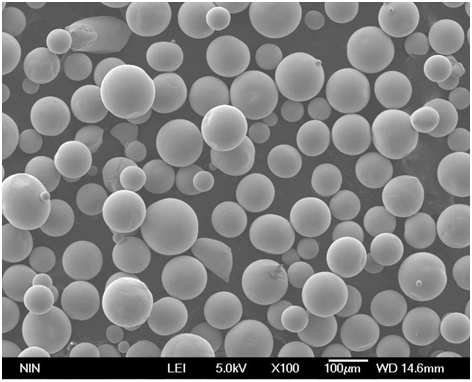
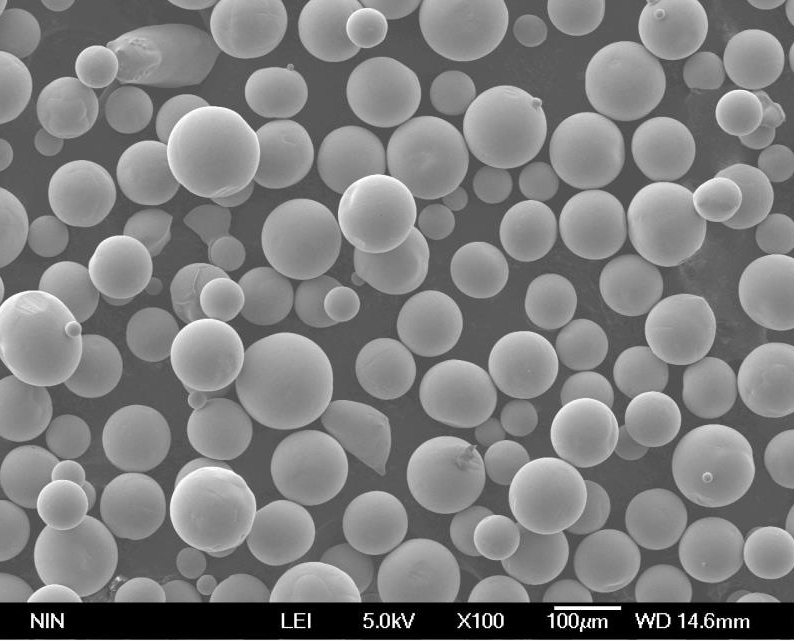
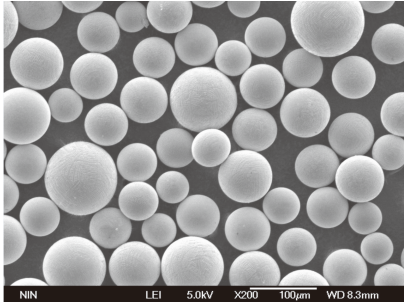
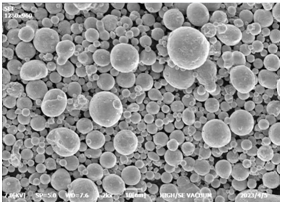

Aplicações do Pó Esférico
Usos Específicos da Indústria
As propriedades únicas do pó esférico o tornam inestimável em vários setores. Veja como diferentes setores estão aproveitando esse material:
| Setor | Aplicativo | Benefícios do Uso de Pó Esférico |
|---|---|---|
| Aeroespacial | Lâminas de turbina, componentes de foguetes | Alta relação força/peso, resistência ao calor |
| Automotivo | Componentes do motor, estruturas leves | Peso reduzido, melhor eficiência de combustível |
| Médico | Implantes, próteses | Biocompatibilidade, precisão na fabricação aditiva |
| Eletrônicos | Tintas condutivas, componentes | Alta condutividade elétrica, precisão na microfabricação |
| Defesa | Blindagem, munição | Densidade para proteção balística, qualidade consistente |
| Energia | Reatores nucleares, painéis solares | Resistência a altas temperaturas, eficiência na conversão de energia |
Como o Pó Esférico está Transformando a Fabricação Aditiva
A fabricação aditiva, ou impressão 3D, é um dos campos mais emocionantes onde o pó esférico está causando um impacto significativo. A uniformidade e a fluidez desses pós são perfeitas para criar designs intrincados e geometrias complexas que seriam impossíveis com os métodos de fabricação tradicionais. Por exemplo, na produção de implantes médicos personalizados, o pó esférico de titânio é usado para criar estruturas que correspondem perfeitamente à anatomia do paciente, melhorando os resultados e reduzindo os tempos de recuperação.
Comparando Diferentes Modelos de Pó Esférico
Comparação Detalhada de 10 Modelos de Pó Esférico
Ao selecionar o pó esférico para uma aplicação específica, é essencial comparar diferentes modelos com base em suas propriedades, composição e custo. Abaixo está uma tabela que compara dez modelos diferentes de pó esférico, destacando seus recursos exclusivos e usos ideais:
| Modelo | Material | Propriedades | Melhor para | Faixa de preço (por kg) |
|---|---|---|---|---|
| Ti-6Al-4V | Liga de titânio | Alta resistência, biocompatível | Implantes médicos, aeroespacial | $350 – $450 |
| AlSi10Mg | Liga de alumínio | Leve, com boas propriedades térmicas | Automotivo, aeroespacial | $100 – $150 |
| 316L | Aço inoxidável | Resistente à corrosão, durável | Dispositivos médicos, ferramentas | $50 – $70 |
| CuNi2SiCr | Liga de cobre | Alta condutividade elétrica | Eletrônicos, dissipadores de calor | $200 – $300 |
| CoCrMo | Cobalto-Cromo-Molibdênio | Biocompatível, resistente ao desgaste | Implantes dentários, dispositivos ortopédicos | $400 – $500 |
| NiCr20TiAl | Liga de níquel | Resistência a altas temperaturas, força | Aeroespacial, energia | $600 – $750 |
| Fe2O3 | Óxido de ferro | Propriedades magnéticas, acessível | Eletrónica, materiais magnéticos | $20 – $40 |
| WNiFe | Tungsténio-Níquel-Ferro | Alta densidade, blindagem contra radiação | Defesa, aeroespacial | $500 – $600 |
Especificações e Normas para Pó Esférico
Principais Especificações e Normas para Pó Esférico
Ao selecionar pó esférico para várias aplicações, é essencial considerar as especificações e normas que garantem a qualidade e o desempenho. Aqui fica uma visão geral detalhada:
| Especificação | Descrição | Normas Comuns |
|---|---|---|
| Tamanho da partícula | Diâmetro das partículas de pó, normalmente medido em micrómetros (µm) | ASTM B330, ISO 3290 |
| Forma da partícula | Esfericidade ou arredondamento das partículas | ASTM B212, ISO 19530 |
| Densidade a granel | Massa do pó por unidade de volume | ASTM B329, ISO 3953 |
| Densidade aparente | Densidade do pó tal como aparece a granel | ASTM B212, ISO 3923 |
| Pureza | Percentagem do material principal vs. contaminantes | ASTM E18, ISO 9001 |
| Fluidez | A facilidade com que o pó flui através de um funil ou calha | ASTM B213, ISO 4490 |
| Composição química | Os elementos ou compostos presentes no pó | ASTM E1621, ISO 6892 |
Tamanhos e Graus Comuns de Pó Esférico
Diferentes aplicações requerem tamanhos e graus específicos de pó esférico. Aqui fica uma tabela que descreve alguns tamanhos e graus comuns:
| Tamanho (µm) | Grau | Usos típicos |
|---|---|---|
| 10 – 20 | Bom | Revestimentos de precisão, fabricação aditiva |
| 20 – 50 | Médio | Componentes automotivos, implantes médicos |
| 50 – 100 | Grosso | Aplicações industriais, fabricação em larga escala |
Fornecedores e Preços para Pó Esférico
Principais Fornecedores e Detalhes de Preços
Aqui fica um instantâneo de alguns fornecedores proeminentes de pó esférico e os seus preços:
| Fornecedor | Tipo de pó | Faixa de preço (por kg) | Local na rede Internet |
|---|---|---|---|
| Ametek | Titânio, alumínio | $300 – $500 | ametek.com |
| Sandvik | Aço inoxidável, Cobalto | $50 – $200 | home.sandvik |
| Höganäs | Ferro, níquel, cobre | $100 – $400 | hoganas.com |
| Grupo ARC | Tungstênio, Zinco | $200 – $600 | arc-group.com |
| Elementum | Silício, Molibdénio | $150 – $400 | elementum3d.com |
Fatores de Preço
O preço do pó esférico pode variar com base em vários fatores:
- Tipo de material: Materiais premium como titânio e ligas de cobalto-crómio são mais caros do que metais padrão como ferro ou alumínio.
- Tamanho da partícula: Os pós mais finos tendem a ser mais caros devido ao processamento adicional necessário.
- Pureza: Os pós de alta pureza geralmente exigem preços mais altos.
Comparando os Prós e Contras do Pó Esférico
Vantagens e Limitações do Pó Esférico
No que diz respeito aos pós esféricos, aqui fica o que precisa de saber sobre os seus benefícios e potenciais desvantagens:
| Aspecto | Vantagens | Limitações |
|---|---|---|
| Fluidez | Fluxo suave e eficiente para fabricação | Pode exigir técnicas específicas de manuseio |
| Densidade da embalagem | A maior densidade resulta em materiais mais fortes | Os pós densos podem ser mais difíceis de processar |
| Acabamento da superfície | Acabamento de superfície superior com pós-processamento mínimo | Custo mais elevado devido aos requisitos de processamento |
| Uniformidade | Qualidade e desempenho consistentes | A produção de pó esférico uniforme pode ser cara |
| Custo | Económico para produção de alto volume | O investimento inicial em pós de alta qualidade pode ser elevado |
Comparação Detalhada: Pó Esférico vs. Pó Irregular
- Pó Esférico: Oferece melhor fluidez e densidade de empacotamento. Ideal para fabricação de precisão e revestimentos de alta qualidade. No entanto, o processamento pode ser mais caro.
- Pó Irregular: Normalmente mais barato, mas pode levar a problemas de fluxo e empacotamento inconsistentes. Mais adequado para aplicações onde a precisão é menos crítica.
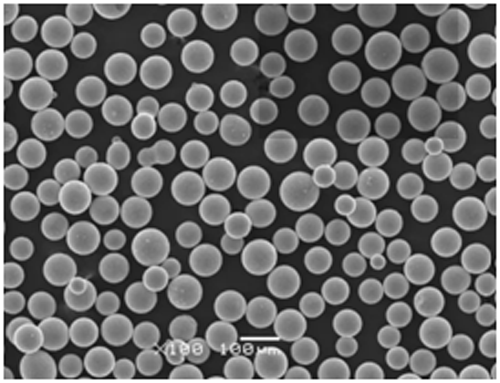
Perguntas frequentes
| Pergunta | Resposta |
|---|---|
| Para que serve o pó esférico? | O pó esférico é usado em uma variedade de aplicações, incluindo fabricação aditiva, componentes automotivos, implantes médicos e eletrónica. A sua uniformidade garante alta qualidade e precisão nestes campos. |
| Como é fabricado o pó esférico? | O pó esférico é normalmente produzido usando técnicas de atomização, onde o metal fundido ou outros materiais são rapidamente arrefecidos para formar partículas esféricas. Outros métodos incluem atomização a gás e atomização a água. |
| Quais são os benefícios de usar pó esférico em impressão 3D? | O pó esférico oferece excelente fluidez e densidade de empacotamento, levando a uma deposição de camada mais consistente e melhor qualidade do produto final na impressão 3D. |
| Como o tamanho das partículas afeta o desempenho do pó esférico? | Partículas mais finas oferecem melhor resolução e acabamento de superfície, mas podem ser mais difíceis de manusear. Partículas mais grossas são mais fáceis de manusear, mas podem não oferecer o mesmo nível de detalhe e acabamento. |
| O pó esférico pode ser reciclado? | Sim, muitos tipos de pó esférico podem ser reciclados, particularmente na fabricação aditiva. No entanto, o processo de reciclagem deve garantir que o pó mantenha a sua qualidade e características. |
| Qual é o custo típico do pó esférico? | O custo varia amplamente dependendo do material, tamanho das partículas e pureza. Os preços podem variar de $20 por kg para materiais comuns a mais de $750 por kg para ligas especializadas. |
| Onde posso comprar pó esférico? | O pó esférico pode ser comprado de fornecedores especializados como Ametek, Sandvik, Höganäs, ARC Group e Elementum. Os preços e a disponibilidade variam com base no tipo e nas especificações do pó. |
